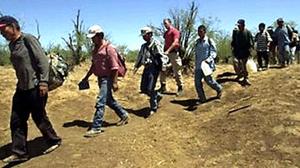Border security / immigrationIllegal immigration into U.S. continues to decline
The Border Patrol made about 463,000 arrests during the federal government’s fiscal year that ended 30 September, down from 556,032 the previous twelve months; this marks the fifth straight year of declines; the Border Patrol arrests are down 72 percent from nearly 1.7 million arrested in 2000; the agency typically makes about 97 percent of its arrests along the 1,952-mile border with Mexico

Crossing the Arizona border // Source: blogspot.com
DHS secretary Janet Napolitano said Monday a 17 percent drop in Border Patrol arrests this year shows heightened enforcement is slowing illegal immigration.
The Border Patrol made about 463,000 arrests during the federal government’s fiscal year that ended 30 September, down from 556,032 the previous twelve months. It marks the fifth straight year of declines.
NPR reports that Border Patrol arrests are down 72 percent from nearly 1.7 million in 2000. The agency typically makes about 97 percent of its arrests along the 1,952-mile border with Mexico, with nearly all the rest coming along the Canadian border.
Napolitano said the weak economy helps explain why fewer people are getting caught crossing the border illegally, and she also credited enforcement against employers. She said, though, that a big reason is enforcement under President Barack Obama — including bringing the Border Patrol to an all-time high of 20,500 agents and dispatching 1,200 National Guard troops.
“The manpower, the technology, the infrastructure all has enabled us to be able to really slow that flow of illegal immigrant traffic,” she said at a news conference at the San Ysidro border crossing with Tijuana, Mexico.
Napolitano also said more drugs, weapons and illicit cash were being seized along the Mexican border. “We now have a border more secure than ever before, and these efforts are only going to continue in the weeks, months and years ahead,” she said.
Peter Nunez, a former U.S. attorney in San Diego who advocates a more restrictive immigration policy, noted that border enforcement has been building for fifteen years. In the mid-1990s, President Bill Clinton launched a crackdown in San Diego and El Paso, Texas, that pushed migrants to remote mountains and deserts and made Arizona the busiest corridor for illegal crossings.
President George W. Bush doubled the size of the Border Patrol to 20,000 agents and, at one point, had 6,000 National Guard troops assigned to the border.
“It’s been a long process over several administrations,” said Nunez, who teaches immigration policy at University of San Diego. “They are reaping the rewards.”
Enrique Morones, an activist who supports looser immigration policies, said the economy is the main reason for the five-year decline in arrests.
“If there are fewer jobs available, fewer people come,” said Morones, president of Border Angels, which provides water to migrants crossing the border.
Morones said enforcement has discouraged people from crossing the border illegally to a much lesser extent. He said the crackdown has led to the deaths of many migrants who tried to evade the Border Patrol by crossing in remote areas in stifling heat.
Border Patrol arrests fell 42 percent in the San Diego region this year, to 68,568 from 118,708. The department did not provide numbers for other regions.
